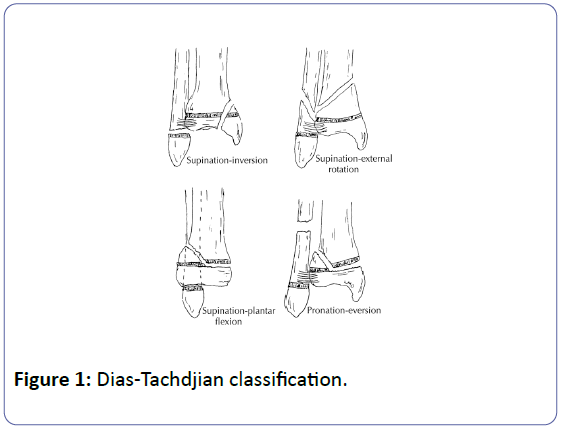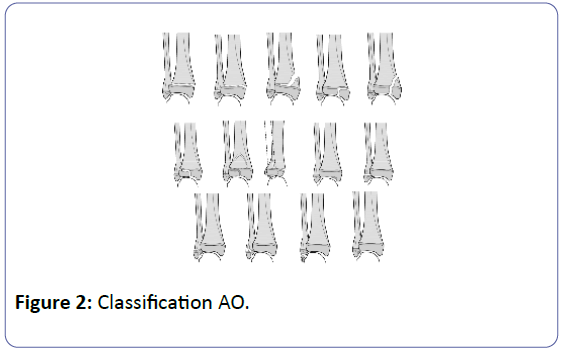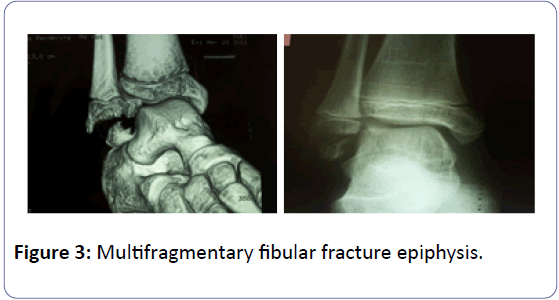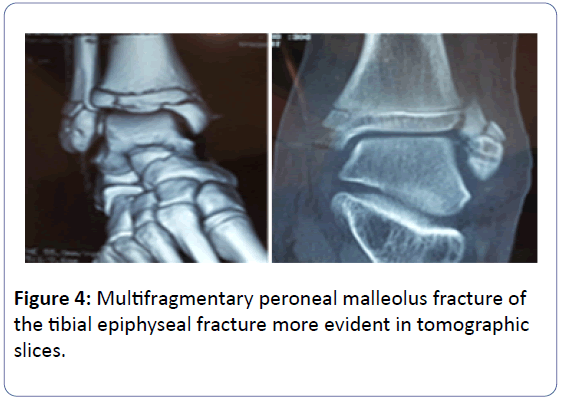A Comparison of Two Classification Systems for Pediatric Ankle Fractures
Baroni Eduardo, Miscione Fernando, Dello Russo Bibiana
DOI10.4172/2471-8416.100022
1Department of Orthopedics and Traumatology, J. P. Garrahan. Pediatric Hospital, Buenos Aires, Argentina
- *Corresponding Author:
- Dello Russo Bibiana
Department of Orthopedics and Traumatology
J. P. Garrahan. Pediatric Hospital
Buenos Aires
Argentina
Tel: 1148078058
E-mail: bibianadellorusso@yahoo.com.ar
Received date: July 15, 2016; Accepted date: August 03, 2016; Published date: August 05, 2016
Copyright: © 2016 Eduardo B, et al. This is an open-access article distributed under the terms of the Creative Commons Attribution License, which permits unrestricted use, distribution, and reproduction in any medium, provided the original author and source are credited.
Abstract
Background: A good fracture classification should provide information about fracture stability and fracture mechanism, and should be a guide for treatment selection with a high degree of reproducibility. The purpose of this study was to analyze the degree of reliability of the two most widely used classification systems for pediatric ankle fractures: The AO classification and the Dias-Tachdjian Classification. Methods: We studied 53 patients, 34 male and 19 female, with ankle fractures. Two classifications, the AO classification and the Dias-Tachdjian classification, were used. Two groups of assessors, one consisting of experienced surgeons and the other of fellows, were asked to classify the fractures. The Cohen Kappa index was used to measure interobserver reliability and to determine interobserver agreement, the Kappa value was deduced using the Fleiss method. Interobserver agreement was measured using the Fleiss kappa coefficient, and intraobserver reliability was measured using the Cohen’s kappa coefficient. Results: The intraobserver and interobserver agreement was not significantly different between the different groups of assessors. Conclusions: In the pediatric age different types of fractures and different mechanisms within an isolated fracture can be found. We found that many of these fracture patterns do not fit in any of the two classifications, which are thus unproductive for surgical planning.
Keywords
AO classification; Dias-Tachdjian classification; Ankle fracture; Comparison between classifications
Introduction
An ideal classification for fractures should provide information on fracture stability, fracture mechanism and, most important, should be a guide for treatment selection with a high degree of reproducibility.
Currently, optimal evaluation and management of ankle fractures in prepubertal and pubertal children is still controversial.
In the pediatric age range ankle fractures account for 11% of all fractures, second in frequency only to distal radius fractures. Distal tibial and fibular physeal injuries have been reported to represent 25% to 38% of all physeal injuries. Five percent of ankle fractures involve the physes [1].
The reliability of the two most commonly used classifications has been poorly evaluated in studies [2].
The Dias-Tachdjian classification is a modified version of the Lauge-Hansen ankle fracture classification for adults. It evaluates the mechanism of injury and the foot position at the moment of trauma. The recent classification of the pediatric AO is based on the fracture mechanism and growth-plate injury pattern associated with the Salter-Harris classification [3].
The aim of this study was to evaluate the interobserver and intraobserver variability for the classification of ankle fractures using the two most commonly used systems in patients with skeletal immaturity.
Material and Methods
Fifty-three patients with ankle fractures, with frontal and lateral X-rays, seen in our Service between 2002 and 2009 were enrolled in the study. Mean age was 13.2 years and 34 patients were male and 19 female. All patients were under 16 years old with open physes. The assessors were divided into two groups, one consisting of two experienced surgeons and another consisting of three fellows. They were asked to classify all ankle fractures according to the AO and the Dias-Tachdjian classification [4,5].
The Dias-Tachdjian classification has five subtypes based on fracture mechanism: Type I (supination-inversion), type II (supination-external rotation), type III (supination-plantar flexion), type IV (pronation-eversion) and type V (transitional fractures, Tillaux-like and triplanar fractures [6]) (Figure 1) The fractures known as transitional fractures are common in adolescents close to the time of skeletal maturity, when the closure of the distal tibial physis has begun. This closure is asymmetric and progressive. These injuries, which occur in Salter-Harris type III y IV, may lead to potential drawbacks, such as partial or complete early closure of the growth plate [7]. This can generate shortening of the affected limb, angular deformity of the ankle axis, and articular surface inconsistency [8].
The current classification of the AO is based on the Muller – AO classification for adult ankle fractures, additionally taking into account the growth cartilage and the division between epiphysis and metaphysis, dividing the fractures into 3 main groups (Figure 2: AO Classification)[9,10].
The assessors were awarded the amount of time needed for evaluation, they were not allowed to discuss their results with their colleagues, and they were not informed about the X-ray re-evaluation [11,12].
Two months later each participant was asked to re-evaluate the same sets of X-rays in a different order, and additionally to describe the hardware used in the surgery, and de quality of the reduction.
Statistical analysis was performed using the Cohen Kappa coefficient for the intraobserver reliability. For the calculation of the Kappa value we used de Fleiss method. The Kappa coefficient was interpreted according to the guidelines proposed by Landis and Koch: < 0.00 poor accuracy; 0.00–0.20 slight accuracy; 0.21-0.40 reasonable accuracy; 0.41-0.60 moderate accuracy; 0.61-0.80 considerable accuracy and 0.81-1.00 accuracy almost perfect [13].
Results
Fracture classification by both groups using the AO system is shown in Table 1 and using the Dias-Tachdjian system in Table 2. For both classification systems the intraobserver and interobserver agreement was significantly different between the experienced surgeons and the fellows.
| AO | Fellows | Surgeons |
|---|---|---|
| 43E/3.1 | 18 | 13 |
| 43E/4.1 | 3 | 3 |
| 43E/2.1 | 5 | 5 |
| 43T-E/6.1 | 8 | 8 |
| 43T-E/5.1 | 8 | 5 |
| 43T-E/4.1 | 3 | 3 |
| 43T-E/3.1 | 5 | 10 |
| 43T-E/2.1 | 0 | 3 |
| 43F-E/7 | 0 | 3 |
| 43F-E/3.1 | 3 | 0 |
| Total | 53 | 53 |
Table 1: Fracture classification by fellows and experienced surgeons using the AO system.
| D-T | Fellows | Surgeons |
|---|---|---|
| Type I | 29 | 29 |
| Type II | 0 | 0 |
| Type III | 0 | 0 |
| Type IV | 8 | 8 |
| Type V | 16 | 16 |
| Total | 53 | 53 |
Table 2: Fracture classification by fellows and experienced surgeons using the Dias-Tachdjian system.
The Kappa interobserver value between surgeons and fellows was 0.90 for the Dias-Tachdjian classification and 0.65 for the AO classification. In the second session, the Kappa values were 1 and 0.76, respectively.
The value of the Kappa coefficient for the hardware selection was 0.48 for the surgeons and 0.38 for the fellows and the Kappa coefficient for the reduction obtained was 0.84 for surgeons and 0.75 for fellows.
Discussion
The aim of this study was to compare the two abovedescribed classification systems. Reproducibility was found to be almost perfect for the Dias-Tachdjian classification system and considerable for the AO classification system.
Nevertheless, although reproducibility of the classifications was reliable, the assessors encountered several problems.
In the Dias-Tachdjian classification, the majority of fractures fell into only one subtype (type I), while the fractures were very different in terms of fracture traces, implant, and surgical management [14-16].
The AO classification, on the other hand, is quite complex leading to a great number of difficulties and requiring considerable training to be able to use the classification. (Figures 3 and 4)
It is well known that in children many different types of fractures and different fracture mechanisms in the same patient may be found. These fracture patterns did not fit in either of the classifications.
The AO classification provides a broader range of options; however, neither classification gives clear examples for the management of the fractures.
In conclusion, both systems may be used to classify the different pediatric fractures. Although the AO pediatric classification is much more complete, neither system is useful for surgical planning.
References
- Jaime C,VillarroelL (2008) Evaluation of the concordance interobservator in pediatrics investigation: Kappa coefficient. Ped Mag Chil 79: 54-58.
- Michael C, Richard C, Mooney JF, Podeszwa DA (2005) “Ankle Joint Biomechanics Following Transepiphyseal Screw Fixation of the Distal Tibia” J PediatrOrthop 25: 635-640.
- Michael C, Richard C, MooneyJF,PodeszwaDA (2005) Transepiphyseal Screw Fixation of the Distal Tibial. PediatrOrthop 25: 635-640.
- Cohen JA (1960) Coefficient of agreement for nominal scales. Educational and psychological measurement20: 37-46.
- Jerome C,Vincent B, Louahem D, Camilleri JP (2008) Salter – Harris Type III and IV Medial Malleolar Fractures Growth Arrest: Is It a Fate? A retrospective Study of 48 Cases with Open Reduction. J PediatrOrthop 28: 652-655.
- Dias LS, Tachdjian MO (1978)Physeal injuries of the ankle in children: classification. ClinOrthopRelat 136: 230-233.
- Harris EJ (1981) Epiphyseal plate injuries in pediatric ankle traumatology. J Foot Surgery20: 145-147.
- Kay RM, Matthys GA (2001)Pediatric ankle fractures: evaluation and treatment. J Am AcadOrthopSurg9: 268-278.
- Landis J, Koch G (1977) The measurement of observer agreement for categorical data. Biometrics 33: 159-174.
- Jeffrey LT, Matthew H, Talerico M, Yong L, Bowe JA (2009)Physeal Fractures of the Distal Tibia. Predictive Factors of Premature Physeal Closure and Growth Arrest. J PedOrthop 29: 356-361.
- Michelson JD, AhnU, Magid D (1995) Economic Analysis of Roentgenogram Use in the Closed Treatment of Stable Ankle Fractures. Journal of Trauma-Injury Infection & Critical Care39: 1119-1112.
- Salter-Harris (2008) Type III and IV Medial Malleolar Fractures Growth Arrest: Is It a Fate? A Retrospective Study of 48 Cases With Open Reduction. J PediatrOrthop 28: 652-665.
- Schnetzler KA, Hoernschemeyer D (2007) The pediatrictriplane ankle fracture. J Am AcadOrthopSurg15: 738-747.
- Theddy FS, Audigé L (2007) Fractures and Dislocation Classification. Compendium for Children, The AO pediatric J Orthop Trauma 21: S1-S133.
- Comprehensive Classification, of Long Bone Fractures (PCCF) (2007) J Orthop Trauma 21: S135-S160.
- Theddy FS,Audigé L (2006Z) Development and Validation of the AO Pediatric Comprehensive Classification of Long Bone Fractures by The Pediatric Expert Group of The AO Foundation in Collaboration With AO Clinical Investigation and Documentation and the International Association for Pediatric Traumatology. PediatrOrthop26: 1.
Open Access Journals
- Aquaculture & Veterinary Science
- Chemistry & Chemical Sciences
- Clinical Sciences
- Engineering
- General Science
- Genetics & Molecular Biology
- Health Care & Nursing
- Immunology & Microbiology
- Materials Science
- Mathematics & Physics
- Medical Sciences
- Neurology & Psychiatry
- Oncology & Cancer Science
- Pharmaceutical Sciences




